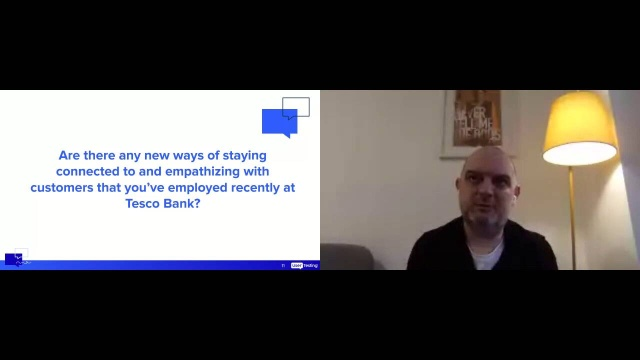
What is voice of customer (VOC)?

The well-known slogan, “the customer is always right,” has echoed through organizations since the turn of the century. While the art of customer satisfaction has grown more nuanced over the decades, this sentiment still rings true. For organizations today, the new challenge is hearing their customers above all the noise. Voice of customer (VoC)programs is a powerful solution for connecting with potential and current customers, as VoC data is vital for decision-making across all teams.
What is voice of customer (VoC)?
A voice of customer solution, sometimes called "VoC," involves collecting insight into customers’ wants and needs through their own words. Although organizations have access to data, there’s often a disconnect between organizations and the needs of their customers. Big data and web analytics are great for identifying trends. Still, trends don’t always speak to the rationale or emotion beneath customer behavior—voice of customer bridges that knowledge gap for organizations.
Voice of customer research shifts the focus from quantity to quality, breadth to depth. VoC asks individual customers a series of questions that probe into the thinking patterns behind their choices and actions. In addition, VoC methods provide a platform for customers to communicate thoughts in their own words so they can feel understood.
For organizations, the ultimate goal of voice of customer research is to understand the emotions clearly and thought processes customers experience with their brand. For customers, the benefit comes from feeling that their thoughts have been acknowledged and their expectations are being met. The best VoC programs don’t just recognize customer sentiment. They enact meaningful change because of it.
Why is voice of customer (VoC) so important?
The days of mom-and-pop institutions and face-to-face customer feedback are slowly becoming less common. Unsurprisingly, the culprit is the internet. From 1995 to 2022, the number of internet users grew from 16 million to more than 5 billion, representing a new universe of business potential that will continue to expand. Online shopping is here to stay and—almost inevitably—take over. In 2022, 21% of global retail sales happened online. However, while the internet made buying and selling more accessible, it created a digital divide between organizations and customers.
Using voice of customer to protect brand reputation
Online shoppers are more empowered to make their feelings about a product or experience known. And those feelings are on display for the world to see. One study by GlobalWebIndex found that half of all internet users post online reviews every month, and more than 70% of online shoppers read one to ten online reviews before purchasing. When a customer’s experience is negative, they leave and take their business to a competitor. When it warrants a bad review, it’s estimated that one review can lose organizations up to 30 potential customers.
In short, customer opinion is a big deal. When customers are upset, they need to be listened to and feel heard. Likewise, organizations need to be aware of their customers' voices to maintain focus and avoid costly mistakes. Having a consistent VoC program allows organizations to react quickly to problems and respond well to negative reviews in order to acknowledge the customer and find a resolution.
Voice of customer in digital product development
Voice of the customer isn’t all about mitigating negative reviews. Sometimes VoC research provides surprising insight that fuels creativity. For years, creating customer personas has been a marketing best practice. The next step in customer-centricity is giving those personas a voice. When you get to the bottom of people’s motivations, sentiments, and beliefs, you can better understand their decisions. Speaking to a pain point draws people in. Speaking to those pain points in a customer’s own words makes people feel like you’re one of them and are on their side. When emotions and feelings are understood, organizations can improve their products and experiences to coincide with those emotions or shift strategies to better address them. For example, suppose voice of customer testing reveals that customers are in love with unexpected aspects or features of a product. In that case, digital product teams can leverage that insight to optimize further.
Voice of customer examples
Voice of customer is an umbrella term for capturing customer feedback in their own words. As such, VoC programs are executed in several different ways.
Customer interviews
Remote or in-person interviews with customers forge human connections. In these moments, organizations can better connect to the customer experience by urging customers to go deeper into how a challenge made them feel, or why the solution is valuable to them, organizations can unearth the emotions that drive decision-making.
Focus groups
Collecting data from focus groups is a way of watching behavior and decision-making in real-time. Spotting similarities and differences between focus group members is enlightening. Asking them to provide context for their responses can lead to exciting agreements or disagreements. This leads to a clearer picture of VoC.
Social media monitoring
Devoting quality assurance and customer satisfaction teams to monitor and respond to VoC on social media can prevent a snowball effect of negativity and show customers that you care about their experience. You can also test your social media campaigns with your audience before launching them to ensure they’re informed by VoC.
Call recordings
Monitoring customer service calls and analyzing transcripts to understand trends of similar sentiment allows organizations to solve common problems customers face. VoC can reveal trends that lead to service improvements in more significant numbers.
Monitor reviews across channels
It’s essential to track reputation across all platforms and review services. If one part of an experience receives more problems than the rest, it’s a clear sign for deeper investigation.
Feedback forms and VoC surveys
Proactively seeking feedback after purchase shows customers that they’re more than a number and that their experience is valued. In addition, voice of customer surveys allow organizations to gather more insight into areas for improvement, successful processes, and more.
Customer-facing employees
Voice of customer techniques aren’t just for customers. Organizations must understand their employees' pain points and wins to know which processes work and which don’t.
Consult the customer journey map
Attaching VoC quotes and proof of customer sentiment to specific touchpoints of a customer journey map is a helpful exercise that gives teams confidence and highlights particular areas for improvement.
Things to keep in mind about VoC
Over the years, we’ve learned to remember a few things about voice of the customer to ensure you’re getting the most value out of your effort.
1. Share customer context across your organization
Great customer experiences are hiding in your data—both quantitative and qualitative. So, don’t silo your insights. As you share feedback and insight across teams, everyone in your organization will be empowered to make customer-centric decisions and gain empathy for your audiences.
2. Customer expectations are rising
Customer experience expectations are incredibly high, and you’re no longer competing with others in your space. You’re competing with every experience your customer has ever had. Think about that. Every Apple, Netflix, and Amazon experience raises the bar for you—in whatever industry you’re in. Customers have come to expect digital experiences to change in real time around them. They expect more personalization and more convenience. Marrying voice of the customer with continuous discovery practices will keep you in sync with rising expectations.
3. Collecting insights is a start, but they need to be actionable
Obtaining insights and sharing them with key stakeholders is an excellent step toward creating a culture driven by customer empathy. However, the most critical step is the number of actions you can take to improve on what you heard from the feedback. Voice of the customer needs to be a more profound knowledge of your customers—beyond just what you hear. Every pause, cringe, and moment of delight you can see from your customers interacting with your product or experience is just as important as what they say. So next time you run a usability test or solicit feedback, make sure you take note of what your users say, what they don’t say, and how they react.
How Tesco Bank incorporates the voice of the customer
We know that customer insight is core to any confident decision, which Janelle Estes, our Chief Insights Officer, and Tesco Bank’s Design Lead, Andrew Dykes, highlighted in their discussion at an event. Their session was focused on how the design team at Tesco Bank builds customer empathy into every stage of the design process—ensuring they’re constantly integrating the voice of their customers into the core of their business. They also discussed how you should relearn your customers in a post-pandemic world to ensure your business remains customer-centric for your changing target customer.
Check out their presentation below to learn more about how customer experience is no longer a nice-to-have but a competitive differentiator that keeps customers happy and loyal.

Getting started with voice of customer
Although technology has drastically increased the number of prospects and opportunities, it’s important to remember that you’ll always be selling to human beings. Ultimately, customer experience is a team effort. And it will take time to build muscle for collecting and sharing insights across the business. Don’t worry, though. It can spread like wildfire. Once a few people start gaining insights that make them think about taking a different, more customer-centric approach to a question or challenge, word will spread about its value, and learning from your customers will become second nature. Customers may forget flashy marketing campaigns and product features, but they won’t forget how the company or product made them feel. When they’re empowered to share those feelings, organizations ensure you’re ready to hear their voices.

Want to learn more?
Explore UX best practices, expert advice, user research templates, and more.





